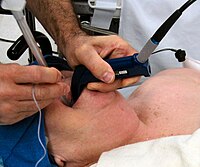
Comparison of Etomidate and Ketamine for Induction During Rapid Sequence Intubation of Adult Trauma Patients
Sign Up to like & getrecommendations! Published in 2017 at "Annals of Emergency Medicine"
DOI: 10.1016/j.annemergmed.2016.08.009
Abstract: Study objective: Induction doses of etomidate during rapid sequence intubation cause transient adrenal dysfunction, but its clinical significance on trauma patients is uncertain. Ketamine has emerged as an alternative for rapid sequence intubation induction. Among… read more here.
Keywords: rapid sequence; trauma; trauma patients; sequence intubation ... See more keywords

Current practices and safety of medication use during rapid sequence intubation
Sign Up to like & getrecommendations! Published in 2018 at "Journal of Critical Care"
DOI: 10.1016/j.jcrc.2018.01.017
Abstract: Purpose: Characterize medication practices during and immediately after rapid sequence intubation (RSI) by provider/location and evaluate adverse drug events. Materials and methods: This was a multicenter, observational, cross‐sectional study of adult and pediatric intensive care… read more here.
Keywords: sequence intubation; medication use; medication; post ... See more keywords

Don't Hold Your Breath—A Video-Based Study of Procedural Intervals During Pediatric Rapid Sequence Intubation
Sign Up to like & getrecommendations! Published in 2022 at "Pediatric Emergency Care"
DOI: 10.1097/pec.0000000000002340
Abstract: Objective Develop a framework for data collection to determine the contributions of both laryngoscopy and tube delivery intervals to the apneic period in unsuccessful and successful attempts among patients undergoing rapid sequence intubation (RSI) in… read more here.
Keywords: rapid sequence; period; tube delivery; sequence intubation ... See more keywords

Comments on "Prehospital Ground Transport Rapid Sequence Intubation for Trauma and Traumatic Brain Injury Outcomes".
Sign Up to like & getrecommendations! Published in 2019 at "Annals of Surgery"
DOI: 10.1097/sla.0000000000003151
Abstract: Annals of Surgery Volume 269, Number 3 urban setting to either prehospital rapid sequence intubation by intensive care trained paramedics or transport to a hospital emergency department for intubation by physicians. The primary outcome measured… read more here.
Keywords: rapid sequence; prehospital ground; comments prehospital; sequence intubation ... See more keywords

Emergency Department use of Apneic Oxygenation Versus Usual Care During Rapid Sequence Intubation: A Randomized Controlled Trial (The ENDAO Trial)
Sign Up to like & getrecommendations! Published in 2017 at "Academic Emergency Medicine"
DOI: 10.1111/acem.13274
Abstract: OBJECTIVES Desaturation leading to hypoxemia may occur during rapid sequence intubation (RSI). Apneic oxygenation (AO) was developed to prevent the occurrence of oxygen desaturation during the apnea period. The purpose of this study was to… read more here.
Keywords: trial; rapid sequence; intubation; apneic oxygenation ... See more keywords

The association of ketamine induction with blood pressure changes in paramedic rapid sequence intubation of out‐of‐hospital traumatic brain injury
Sign Up to like & getrecommendations! Published in 2021 at "Academic Emergency Medicine"
DOI: 10.1111/acem.14256
Abstract: Rapid sequence intubation (RSI) is used to secure the airway of traumatic brain injury (TBI) patients, with ketamine frequently used for induction. Studies show that ketamine‐induction RSI might cause lower blood pressures when compared to… read more here.
Keywords: traumatic brain; rapid sequence; injury; blood ... See more keywords

Mixed‐methods pilot study exploring the influence of the novel Paediatric Anaesthetic Drug Solution tool on clinician cognitive load during simulated paediatric rapid sequence intubation in the emergency department
Sign Up to like & getrecommendations! Published in 2023 at "Journal of Paediatrics and Child Health"
DOI: 10.1111/jpc.16396
Abstract: Rapid sequence intubation (RSI) in children is a low‐incidence, high‐risk event associated with cognitive overload and potential errors producing unfavourable outcomes. Cognitive aids, such as charts, algorithms and flow diagrams, are prompts that externalise and… read more here.
Keywords: drug solution; cognitive load; sequence intubation; rapid sequence ... See more keywords

Rapid Sequence Intubation Standardization and Improvement Process in the Pediatric Emergency Department
Sign Up to like & getrecommendations! Published in 2018 at "Pediatrics"
DOI: 10.1542/peds.142.1_meetingabstract.115
Abstract: Background: Rapid Sequence Intubation (RSI) is the standard definitive airway management in the pediatric emergency department (PED). There are limited data describing time to intubation (TTI), adverse events (AE), and process variation for RSI in… read more here.
Keywords: pediatric emergency; rapid sequence; intubation; emergency department ... See more keywords

“COMPARATIVE EVALUATION OF ETOMIDATE AND THIOPENTONE SODIUM WITH ROCURONIUM FOR RAPID SEQUENCE INTUBATION IN PREGNANT PATIENTS UNDERGOING LOWER SEGMENT CAESEREAN SECTION (LSCS)” A COMPARATIVE STUDY.
Sign Up to like & getrecommendations! Published in 2017 at "International Journal of Approximate Reasoning"
DOI: 10.21474/ijar01/2888
Abstract: e aim of this study was to compare the intubating conditions and haemodynamic response for rapid sequence intubation (RSI) of the induction agents, etomidate and thiopentone sodium, with a rapid acting neuromuscular blocking agent rocuronium… read more here.
Keywords: rocuronium; rapid sequence; intubation; sodium ... See more keywords